Insights
Customer communication and the generations: Does age matter?
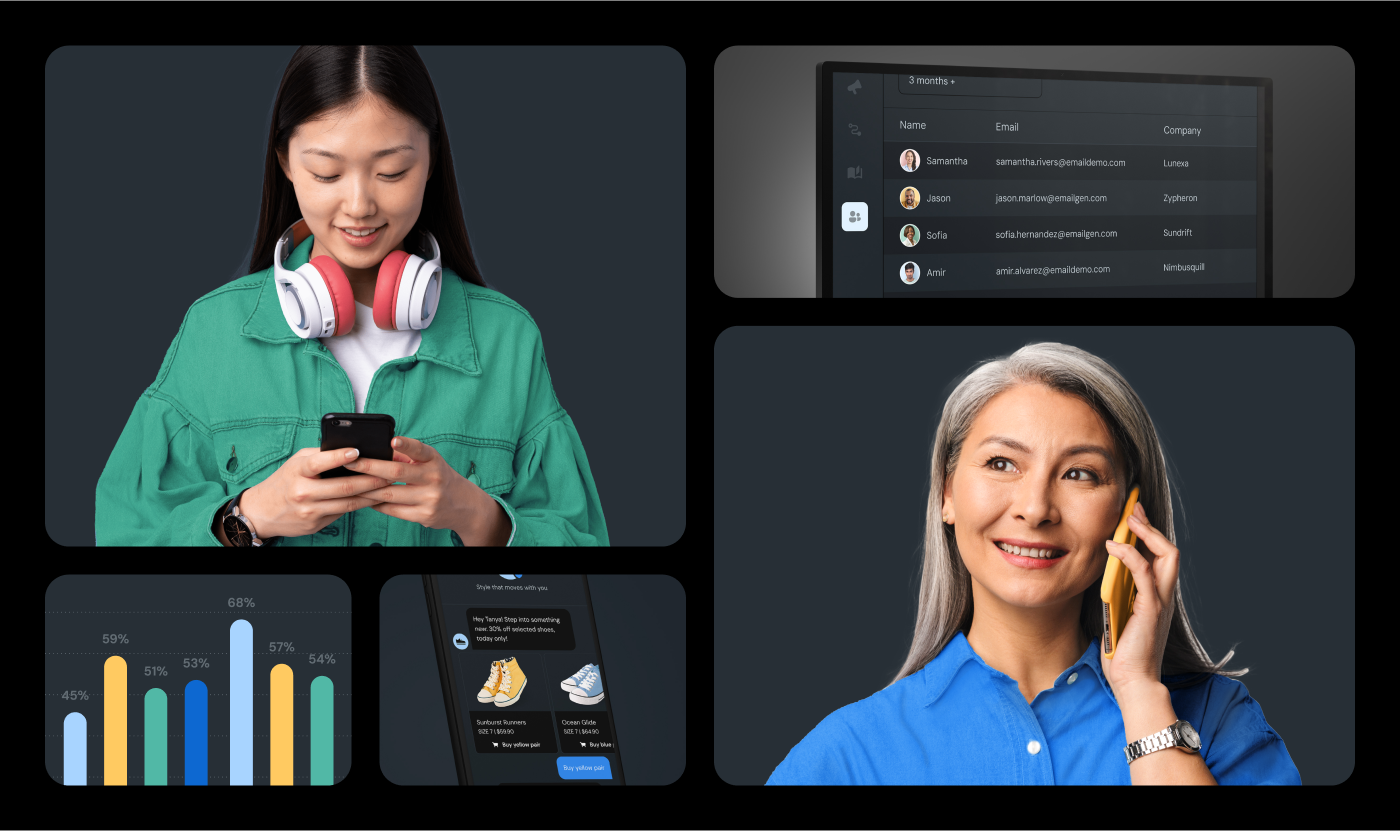
Insights

People love boxing the world up into neat little packages and so do businesses. It helps everyone make sense of this unpredictable thing called life – or consumer behavior – whatever the case may be.
An easy and often useful way to categorize others is by their age group or generation. Discussing what baby boomers, millennials, Gen-Z, and now Gen Alpha want is always a hot topic. (Sorry, Gen Xers. Forgotten again. You too, of course.)So, how much does the age of a customer impact the way your business communicates with them? Does choosing the right channel matter at all? Let’s look at some findings from Sinch’s new report, The state of customer communications.
Here at Sinch, we’re big believers in the idea that there’s no such thing as a one-size-fits-all customer communication strategy.
Every contact in your database represents an individual with their own needs and expectations. Your goal should be to provide a personalized customer experience through timely, relevant messages that make customers feel seen and heard.
That said, in some ways, people are often more alike than different.
Sinch surveyed 2,800 consumers from 12 countries around the world to learn more about their preferences for customer communication. If we filter the research along generational lines, there are times when things barely change – and others where there is a clear difference in opinions.
Here’s how we categorized four key generations for our report:
Baby boomers: Born 1946 – 1964
Generation X: Born 1965 – 1980
Millennials: Born 1981 – 1996
Generation Z: Born 1997 – 2012
Keep in mind, we only surveyed consumers ages 18 and older, which gave us a slightly smaller pool for Gen Z. Responses also included a marginal number (3%) of people from the Silent Generation, born before 1946.
Sinch CMO, Jonathan Bean, questions whether it’s wise to build a communication strategy based on generational preferences. After all, generations are just imaginary lines we use to define groups. Is a millennial born in 1995 that much different from a Gen Z consumer born in 1998? Maybe and maybe not. The key is to make customer communications feel like a one-to-one experience.
“Cross-generational success depends on how well brands listen to consumers. That starts with real preference tracking and ends with experience design that can flex. Rather than separate strategies for each generation, brands need systems that adjust to individual behaviors, not age.”

Truly understanding your customer, however, can begin with the big picture. Start looking at your customers with binoculars before you break out the microscope and get down to the finer details.
Two types of communications nearly all businesses deliver are marketing messages, like promotional campaigns that keep people engaged, and customer updates, including transactional messages that keep people informed.
Across all generations, 77% of consumers would choose email as one of their preferred channels for receiving promotional messages. Text messaging (including SMS, MMS, and RCS in this question) was the second most popular option for promotions.
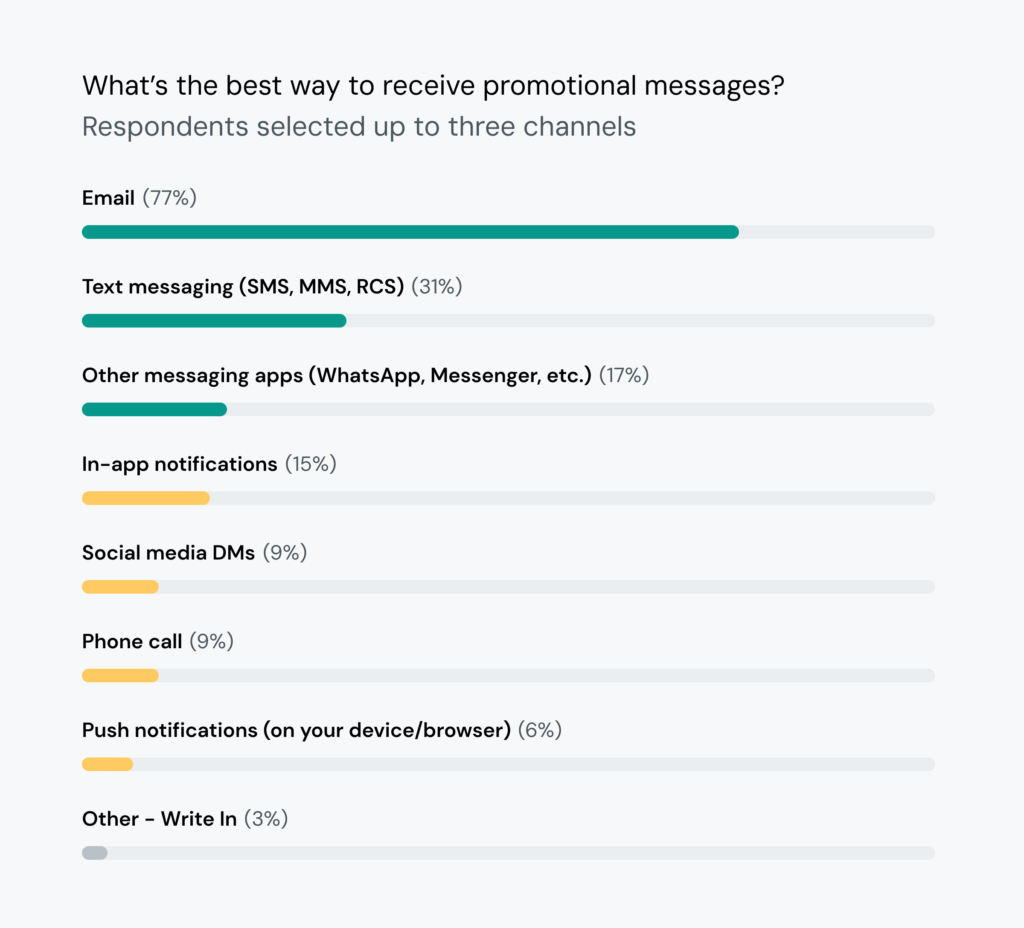
While there are some differences among the four generations, email was the most chosen option for all groups. Gen Z had the smallest cohort of email lovers, with about two-thirds choosing the channel.
Baby boomers who want promotions delivered via email.
Gen Xers who want promotions delivered via email.
Millennials who want promotions delivered via email.
Gen Z respondents who want promotions delivered via email.
Even though 14 percentage points separate the oldest and youngest consumers, email marketing promotions seem to be preferred by many people – no matter the age group.
There are similar gaps among the four generations when it comes to receiving promotions on their phone’s native messaging app. In this case, Generation X (26%) was a bit less likely than baby boomers to prefer these mobile messages while more than 40% of Gen Z survey participants chose the option.
Baby boomers who want promotional messages via their phone’s native messaging application.
Gen Xers who want promotional messages via their phone’s native messaging application.
Millennials who want promotional messages via their phone’s native messaging application.
Gen Z respondents who want promotional messages via their phone’s native messaging application.
Millennial and Gen Z respondents were also slightly more likely than older consumers to want promotions delivered on OTT channels like WhatsApp and Messenger, which we called “Other messaging apps” in the survey. Around 28% of Gen Z and millennial consumers chose this option compared to 15% of Gen X respondents and 7% of baby boomers.
When asked about customer updates, we saw similar consumer preferences for email and SMS. While just over half of respondents said email was their top choice for informational messages, around a quarter of consumers wanted both an email and text update.
The big takeaway? You need a multichannel customer communication strategy to reach customers with promotions and updates. The research shows 58% of global consumers want to choose their preferred channel when opting in. More than 1 out of 10 would choose more than one channel.
While there are some slight yet noticeable differences in communication channel preferences among generations, all ages seem to agree on what makes brand communications frustrating and annoying.
When we asked consumers to select their three biggest pain points with both promotional campaigns and informational updates, their number one complaint was messages that are excessive or too frequent.
The chart below reflects consumer frustrations with informational customer updates.
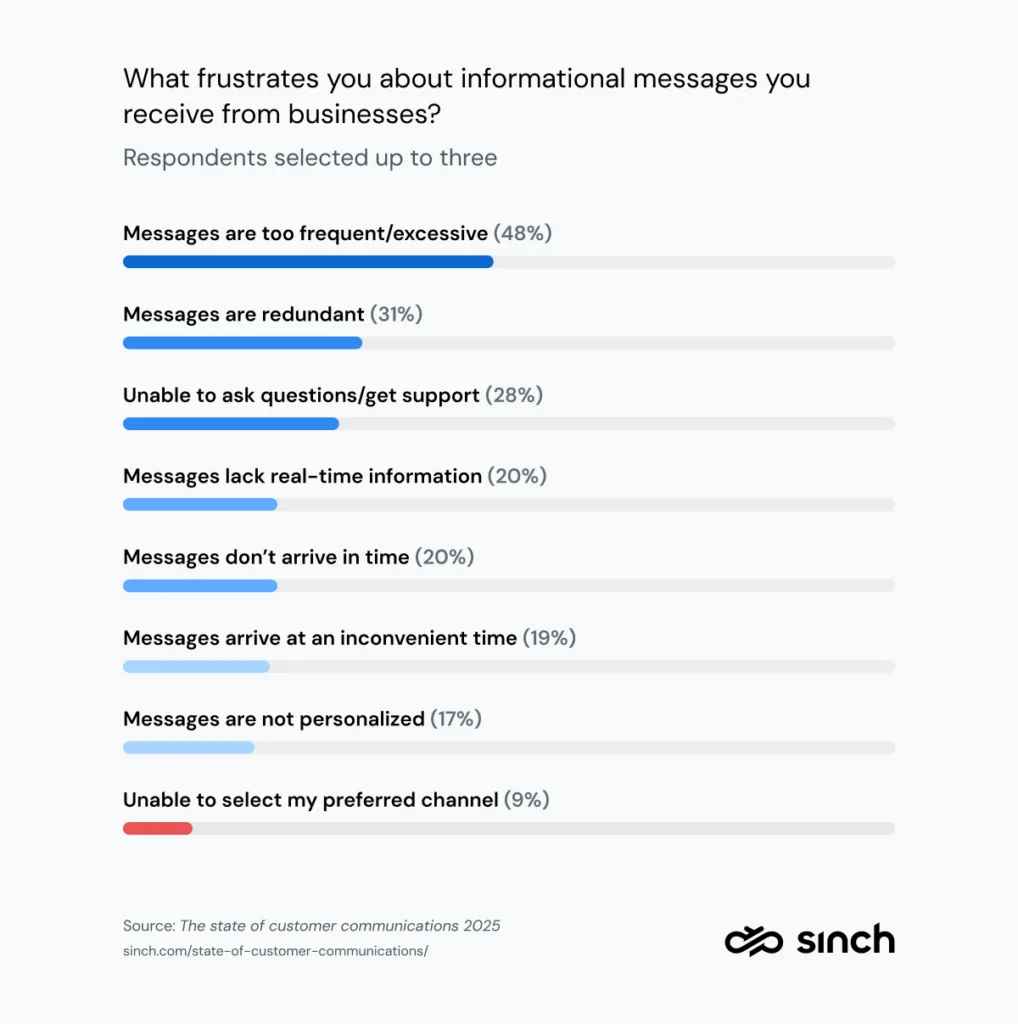
Redundant updates, repetitive offers, irrelevant messages, and the inability to ask questions were all cited as frustrations around the same amount no matter the generation.
What does this tell you? Being too invasive with customer communications and sending irrelevant or unnecessary messages will frustrate just about everyone. You want people to anticipate your messages; you don’t want to annoy them. So, send wisely.
Personalized messages from a business that knows what you need and want are much less likely to be seen as annoying or irrelevant. Much like their communication frustrations, personalization preferences also seem to span the generations.
Among people of all ages, matching their personal preferences was the most popular way to have messages personalized. 42% of all consumers chose this option as an expectation, but it jumps to more than half for the two younger generations.
Baby boomers who expect messages to be personalized with their preferences.
Gen Xers who expect messages to be personalized with their preferences.
Millennials who expect messages to be personalized with their preferences.
Gen Z respondents who expect messages to be personalized with their preferences.
Expectations for more advanced personalization are higher among younger consumers. Using a first name won’t impress them at all. As digital natives, they’ve grown up in a world where data and algorithms delivered experiences tailored to their interests. The biggest difference in generational preferences for personalization is found among consumers who don’t want to receive personalized messages at all. Baby boomers are much more likely than Gen Z consumers to say they don’t want any personalized communications.
While almost 37% of boomers don’t want personalized messages from brands, only 7% of Gen Z respondents felt that way about personalization.
As an elder millennial growing up in the early ‘90s – or the late 1900s if you prefer – I found myself trying to convince my dad I should get a CD player for Christmas.
“Why do you need CDs when we already got all these tapes?” my laggard of a father would ask. It didn’t matter how much I explained the improved sound quality or the freedom of never having to rewind a cassette again. He was a bit stuck in his ways and resistant to change.
Of course, he eventually gave in. I got a CD player (with a tape deck too). Today, my dad streams Emerson, Lake & Palmer from his Pandora account. I tell you that story as a reminder that younger consumers are almost always the first to adopt new technology while the rest of us follow suit in good time.
According to Sinch’s research, that seems to be the case for emerging customer communication channels, including Rich Communication Serices (RCS) as well as solutions driven by artificial intelligence (AI).
RCS for Business lets brands deliver much more engaging experiences through the native messaging app on consumer smartphones. Think of a basic SMS. Now think of an app-like experience inside a mobile message. You’re starting to get the idea, but you can learn much more in Sinch’s RCS hub.
59% of business respondents in our research believe RCS will be game changing for customer communications in their industries. However, one of the most basic features of RCS is already delivering a lot of value.
There is a strict authentication process for becoming a verified sender of RCS messages. But once a brand becomes a verified sender, every RCS message they send is delivered with their official logo and a check mark. These are visual cues to the recipient that messages are safe and not phishing scams.
The research shows these elements really do improve trust in messaging for consumers. A combined 79% of consumers say logos and checkmarks make them at least somewhat more likely to trust a message is safe.
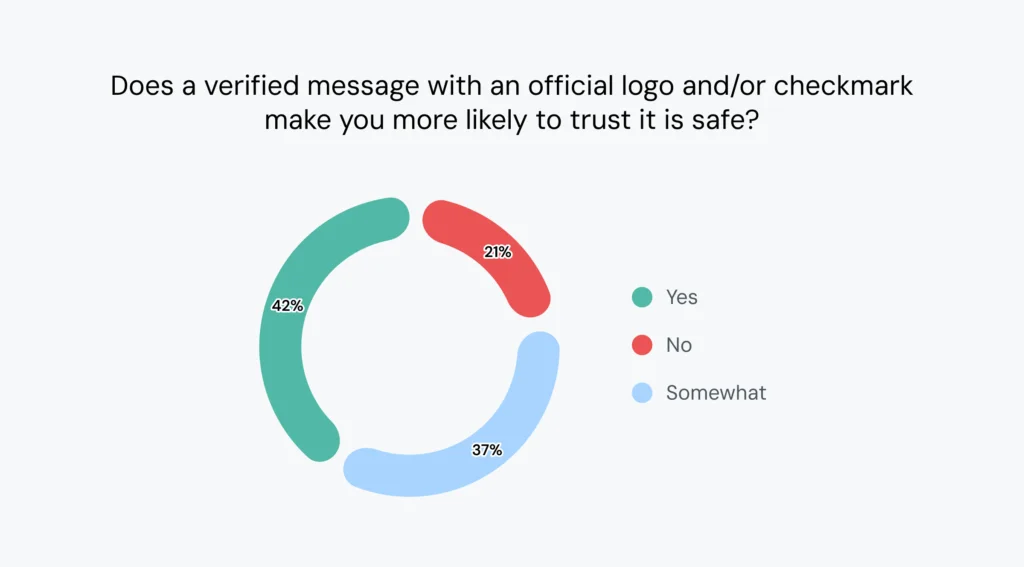
Interestingly, younger consumers put much higher faith in those logos and check marks than their older counterparts. We break down the generational viewpoints below showcasing the percentage who said “Yes” to the question.
Gen Z respondents who say that RCS trust marks make messages feel safer.
Millennial respondents who say that RCS trust marks make messages feel safer.
Gen X respondents who say RCS trust marks make messages feel safer.
Baby boomer respondents who say that RCS trust marks make messages feel safer.
Perhaps digital natives are more familiar with check marks as a trust signal. They’re used on everything from social media accounts and dating apps to Amazon verified purchases and WhatsApp messages.
Even though a smaller number of boomers and Gen Xers answered “Yes,” a much higher percentage indicated they’d feel at least somewhat safer interacting with messages that came with a recognizable logo and check mark.
Whether you call it an evolution or a revolution, AI is changing many things, including customer communications. Sinch’s research found 97% of business respondents are using or plan to use AI to enhance their communication strategies.
That includes 63% who expect to invest in AI voice assistants in 2025 and 43% who plan to build AI-powered chatbots.
Communications connected to customer support keep people happy, and AI is positioned to greatly improve those experiences. But are consumers ready for it?
Our survey reveals that willingness to work with AI solutions may be one of the starkest differentiators among consumers of different ages. While more than 70% of Gen Z respondents are willing to work with an AI chatbot trained on support documentation, only 20% of baby boomers have the same comfort level.
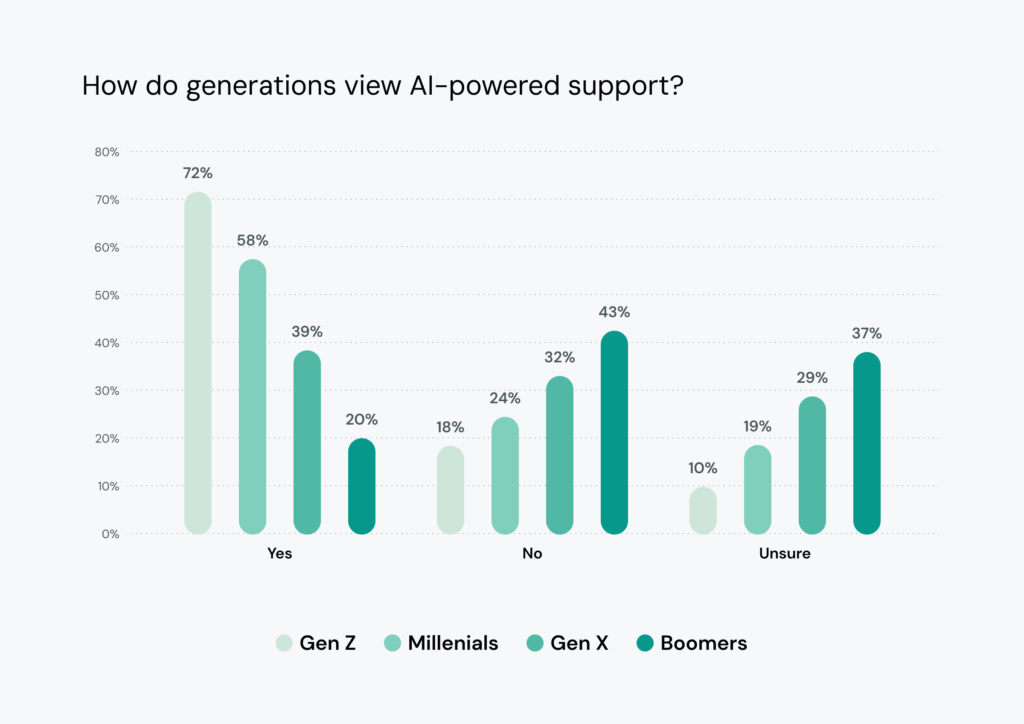
In general, it seems that the younger consumers are, the more likely they are to be comfortable engaging with AI for customer support. It’s best to take these findings with a grain of salt. Opinions around artificial intelligence and usage of AI are changing quickly.
Asking boomers and Gen X about AI directly may prompt some skepticism and hesitancy. The truth is, however, many of these older consumers are already using AI solutions daily.
That could be an Amazon Alexa device in their home, Siri on their iPhone, or Gemini with Google devices and products. Plus, major retailers like Amazon and Walmart have AI-powered tools that answer questions and make recommendations. When done well, consumers almost forget they’re interacting with AI.
Younger generations are eager for AI-driven experiences, but older consumers may approach automation with more caution. The brands that win are those that build trust while using AI transparently, respectfully, and with a clear opt-in.
One reason a business may decide to focus on customers from one generation over another is their spending power as a consumer group. For instance, if baby boomers are the target audience, and they have all the money, should you prioritize the preferences of younger consumers?
Amy Poehler has a funny take on the generations and their stereotypical points of view about personal finances. Check it out:
It’s a hilarious bit, but this kind of stereotyping is exactly where you can miss the mark. Just because a statement is true for the group doesn’t make it true for the individual.
In the United States, Federal Reserve data indicates baby boomers hold nearly half the nation’s wealth while Gen X has more than a quarter and millennials hold around 13%. But that doesn’t mean every millennial is broke, and every boomer is sitting on a pile of cash. There’s more to it than that.
It’s a fluid situation. You need to think about the present as well as the future while expecting the unexpected. For example, it may not be long before Generation Z drives consumer spending. Bank of America research predicts Gen Z will be the richest generation in 2035. And Nielsen says Gen Z’s spending power will be $12 trillion by 2030.
At one point, there were plenty of similar headlines about how powerful millennial consumers would become. Then there was a global recession just as many hit the job market, which was followed by a global pandemic as they were finally regaining momentum.
Who knows what could happen next and how it might affect consumer behavior? The key is understanding where people are and using customer communications to provide relevant messages as well as a little empathy and understanding.
Since we’re already on the topic of money, here are some examples of how to tailor customer communication for different generations in the financial services industry:
Baby boomers may appreciate face-to-face video calls with financial advisors to help them with wealth management and estate planning.
Generation X could use email sequences and SMS updates that educate and inform them on retirement savings as they move out of the workforce.
Millennials may find value in discussing financial decisions with an AI chatbot trained to offer advice on milestones, like getting a home or auto loan.
Generation Z will likely enjoy engaging with interactive RCS experiences that gamify personal finances.
Sinch provides enterprise cloud communication solutions, which is a big part of an omnichannel strategy, but not all of it. Choosing the right channels is the how of scalable customer communications that meet consumer preferences. The what and the why requires that you understand the people you serve.
Generational preferences, as well as the different challenges, ambitions, and perspectives, give you a place to start. Beyond that, your digital communication experiences should become more tailored to each individual customer’s needs.
It certainly feels as if we’re on the edge of a major shift that GenAI is catalyzing. The state of customer communications found that the healthcare, FinServ, retail, and tech sectors are moving forward with AI in customer communications.
That means consumers are coming along for the ride. It also means now is the time for your business to start considering the changes that are coming, which includes the next generation of consumers, Gen Alpha.
Experts often call millennials and Gen Z “digital natives.” It’s likely we’ll refer to the youngsters born in the last 15 years “AI natives.” They grew up barking out orders to Alexa until it played Baby Shark.
For Gen Alpha, interacting with AI will be as natural as Gen X checking email. My own Gen Alpha kid has honestly asked me what Gmail does. “Can it send texts?”
Customer communication could look very different in another decade. Whatever happens, count on Sinch to help simplify the complexities and guide you through the changes.